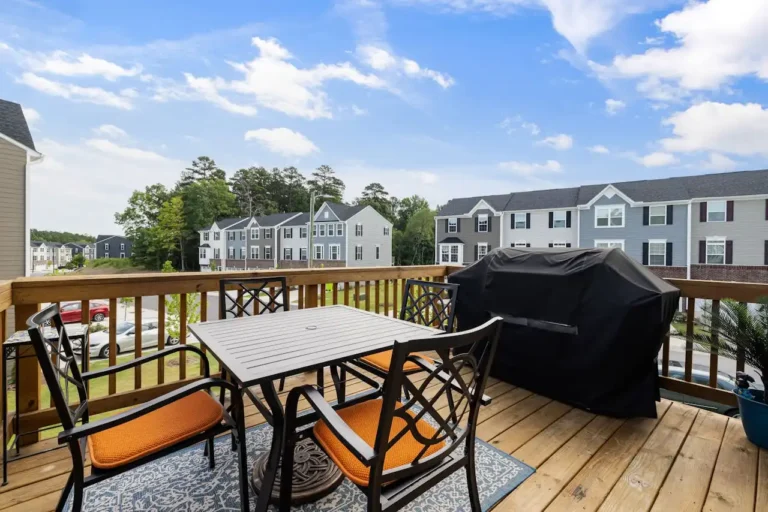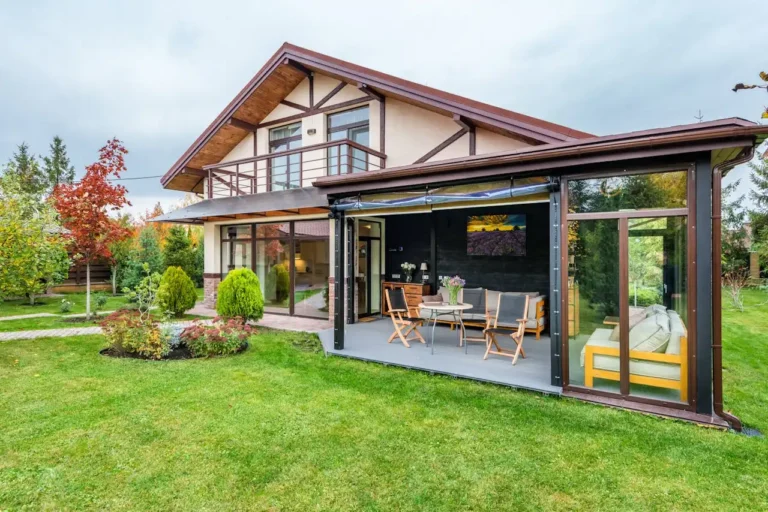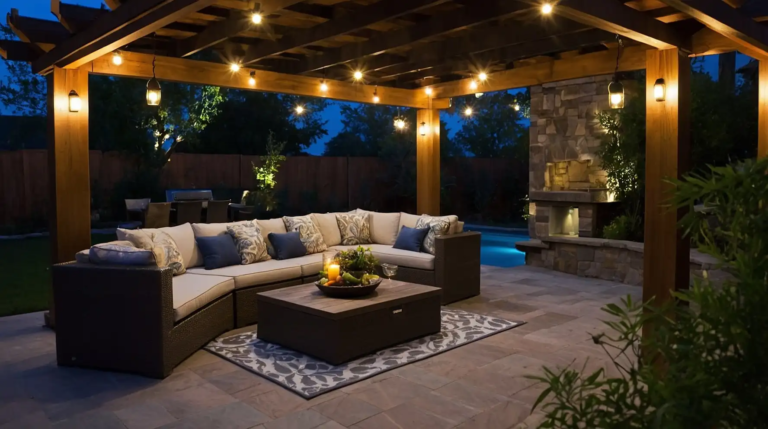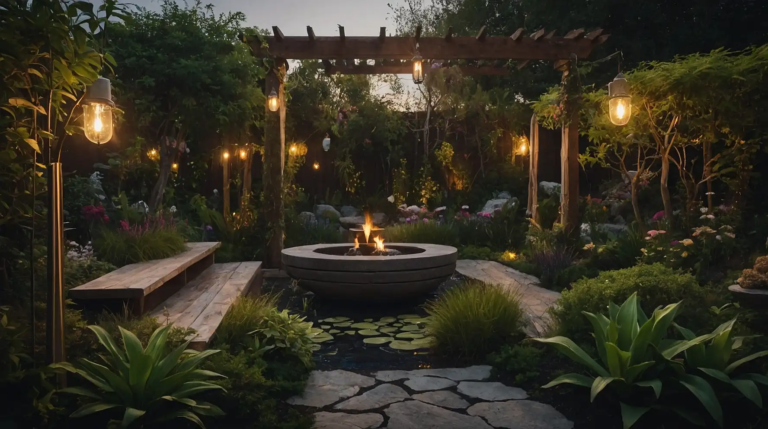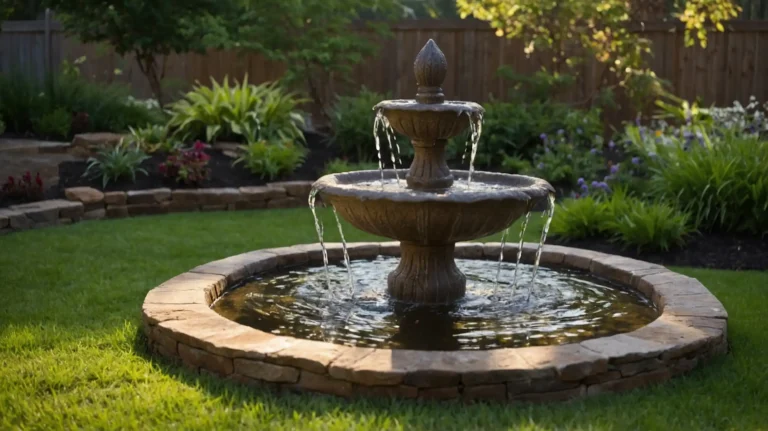25 Stunning River Rock Landscaping Ideas to Transform Your Outdoor Space
River rocks bring natural beauty, durability, and low maintenance to your landscape design.
These smooth, water-worn stones add texture and visual interest while serving practical purposes like controlling erosion and reducing water usage.
Unlike mulch or gravel that requires frequent replacement, river rocks create permanent landscape features that only improve with age.
Their varied colors and sizes offer endless design possibilities for any outdoor space.
Whether you’re looking to create stunning focal points or solve persistent drainage issues, these 25 river rock landscaping ideas will inspire you to incorporate these versatile stones into your outdoor environment.
1: Dry Creek Bed Feature

Create a decorative dry creek bed that mimics a natural waterway winding through your yard.
Use varying sizes of river rocks to simulate the natural flow patterns of an actual stream.
Add larger boulders along the edges to anchor the design and create visual interest.
Plant moisture-loving perennials and ornamental grasses along the banks for a naturalistic look.
Install landscape fabric underneath to prevent weed growth while allowing proper drainage.
2: River Rock Garden Edging

Define your garden beds with clean, crisp river rock borders that create permanent separation between lawn and planting areas.
Choose stones of similar size for uniform borders or varying sizes for a more natural look.
Dig a shallow trench about 2-3 inches deep to nest the rocks securely.
Install edging material between the lawn and rocks to prevent grass from invading your borders.
Consider using contrasting rock colors to highlight specialized garden areas like herb or vegetable beds.
3: Japanese-Inspired Rock Garden

Create a tranquil Zen garden using river rocks as the primary element.
Arrange larger stones as focal points surrounded by fields of smaller river pebbles raked into meditative patterns.
Include minimal plantings like Japanese maples, bamboo, or ornamental grasses for contrast.
Add a simple bench or seating area to encourage contemplation and relaxation.
Consider incorporating a small water feature to enhance the peaceful atmosphere with gentle sounds.
4: Functional Rain Garden

Build a depression filled with river rocks to capture rainwater runoff from your roof or driveway.
Layer different sizes of stones with the largest at the bottom for maximum water filtration.
Plant water-tolerant native species around the edges that can handle both wet and dry conditions.
Position the garden at least 10 feet from your home’s foundation to prevent moisture problems.
Incorporate larger statement boulders to add visual interest to this practical landscape feature.
5: River Rock Pathway

Construct a welcoming pathway using flat river stones set in sand or decomposed granite.
Select rocks with relatively flat surfaces for comfortable walking while maintaining the natural appearance.
Leave small gaps between stones to allow for groundcover plants like creeping thyme or moss.
Ensure proper drainage by building the path on a slight crown that sheds water to the sides.
Edge your pathway with larger river rocks to contain the walkway and create a finished look.
6: Stone Mulch Around Trees

Replace traditional organic mulch around trees with a permanent river rock installation.
Create a circular or organic-shaped border around your trees extending to the drip line.
Choose smaller pebbles (3/4″ to 1-1/2″) for better coverage and easier maintenance.
Leave a few inches of space around the trunk to prevent moisture retention against the bark.
Consider contrasting stone colors that complement your home’s exterior or other landscape elements.
7: River Rock Retaining Wall

Build short decorative retaining walls using large river rocks stacked thoughtfully to hold back soil on sloped areas.
Select flat-sided rocks that nest together naturally for stability.
Incorporate smaller stones to fill gaps between larger rocks for a polished appearance.
Plant cascading groundcovers at the top that will spill over the wall for softness.
Ensure proper drainage behind the wall with gravel backfill and drain pipe for longer-lasting results.
8: Water-Wise Rock Garden

Create a drought-tolerant garden bed using river rocks as both decoration and practical mulch.
Select rocks in colors that complement your chosen plant palette.
Plant hardy succulents, ornamental grasses, and native perennials that thrive in well-drained soil.
Incorporate larger specimen rocks as focal points throughout the garden bed.
Arrange rocks to direct any rainfall toward plant root zones for natural irrigation.
9: River Rock Fire Pit Surround

Design a safe, attractive border around your fire pit using river rocks of consistent size.
Choose heat-resistant stones approximately 4-6 inches in diameter for optimal safety and appearance.
Create a border at least 2-3 feet wide around your fire pit to define the space.
Consider embedding the stones in concrete for permanent installation or laying them loose for flexibility.
Add a few larger boulders as informal seating or decorative elements around the perimeter.
10: Riverstone Mosaic Patio

Create an artistic patio surface using flat river stones arranged in decorative patterns.
Set the stones in mortar on a concrete base for a permanent, stable installation.
Choose stones with similar thickness but varying shapes and colors for visual interest.
Fill gaps between stones with smaller pebbles or appropriate grout material.
Seal the finished surface to enhance the natural colors and protect from staining.
11: River Rock Fountain Feature

Construct a recirculating water feature using river rocks to create natural-looking cascades.
Arrange stones of varying sizes to mimic a mountain stream or gentle waterfall.
Hide the pump and plumbing components beneath carefully placed larger rocks.
Include some partially submerged flat rocks where birds can perch for bathing.
Add underwater lighting to create dramatic evening effects that highlight the water’s movement across the stones.
12: Gabion Rock Wall

Build contemporary landscape features using wire gabion baskets filled with river rocks.
These permeable structures provide excellent drainage while creating clean, modern lines.
Use as retaining walls, privacy screens, or decorative elements throughout your landscape.
Consider mixing stone colors or incorporating glass pieces for unique visual effects.
Plant cascading flowers or trailing vines along the top to soften the industrial appearance of the wire structure.
13: River Rock Succulent Garden

Design a low-maintenance succulent display using river rocks as both background and feature elements.
Choose smaller polished stones in colors that complement your succulents’ natural hues.
Create slight mounds and depressions to add topographical interest to your design.
Position larger specimen rocks strategically to serve as anchor points among the plantings.
Consider adding crushed rock in contrasting colors to highlight specific areas or create paths between plant groupings.
14: Drainfield Rock Garden

Transform problematic drainage areas into attractive landscape features using river rocks of varying sizes.
Create a basin-shaped depression where water naturally collects during rainstorms.
Layer rocks from largest at the bottom to smallest on top for maximum filtration.
Add moisture-loving plants around the edges that can handle occasional flooding.
Shape the installation to appear natural, like a dry riverbed that would typically fill after rain.
15: River Rock Stepping Stones

Create an informal pathway using large, flat river rocks as individual stepping stones.
Space the stones at a comfortable walking distance (typically 24-26 inches on center).
Partially embed each stone into the soil for stability and to prevent tripping hazards.
Plant low-growing groundcover between stones to soften edges and create a cohesive look.
Select stones of similar thickness but varying shapes for natural character and visual interest.
16: Rock-Rimmed Pond Edge
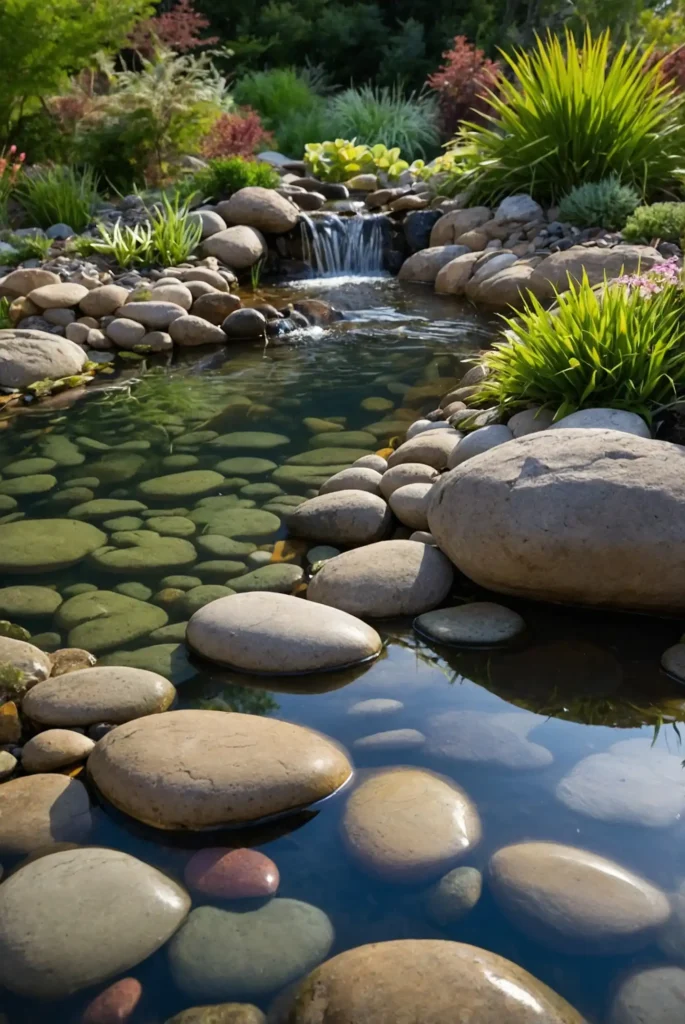
Define the perimeter of a garden pond with carefully arranged river rocks of varying sizes.
Create a natural transition from water to land with smaller pebbles near the water gradually increasing to larger stones.
Stack rocks strategically to create small overhangs where fish can hide from predators.
Incorporate flat stones that extend slightly over the water’s edge as access points for wildlife.
Plant marginal aquatic species between rocks at the pond’s edge for a complete ecosystem.
17: Riverstone Driveway Border

Line your driveway with river rocks to create an elegant, low-maintenance border.
Choose medium-sized stones (2-4 inches) that won’t easily scatter onto the driveway surface.
Install landscape fabric underneath to prevent weed growth and soil mixing.
Consider adding landscape lighting among the rocks for nighttime definition and safety.
Use consistently colored stones for formal designs or mixed colors for more natural appearances.
18: River Rock Container Gardens

Fill decorative pots with river rocks instead of soil for striking succulent and air plant displays.
Choose smaller, polished stones in colors that enhance your plant selections.
Position plants so they appear to emerge naturally from between the rocks.
Add slow-release fertilizer pellets among the stones to provide nutrition for your plants.
Mist regularly, as these arrangements provide excellent drainage but minimal water retention.
19: Meditation Circle

Create a sacred space in your garden using river rocks arranged in a perfect circle or spiral pattern.
Use stones of consistent size for the path and larger specimens as focal points or seating.
Position the circle in a quiet corner of your garden away from household activity.
Plant aromatic herbs or flowers around the perimeter to engage multiple senses.
Consider incorporating meaningful symbols or alignments with sunrise/sunset positions for additional significance.
20: River Rock Erosion Control

Stabilize slopes and prevent soil washout by installing river rock erosion barriers.
Use larger stones (4-8 inches) at the base of slopes with gradually smaller stones above.
Create small terraces or check dams across the slope to slow water movement.
Plant deep-rooted native species between rock groupings for additional soil stabilization.
Ensure rocks are partially embedded into the soil rather than simply placed on the surface.
21: Decorative Dry Well

Construct an attractive solution for downspout drainage using river rocks as both functional filter and landscape feature.
Dig a basin at least 3 feet deep filled with progressively smaller stones.
Direct rainwater into the basin through decorative rock channels or buried pipes.
Plant water-loving species around the edges to benefit from occasional overflow.
Add larger decorative boulders around the perimeter to define the area as an intentional garden feature.
22: River Rock Tree Ring Planter

Create a decorative planting bed around trees using river rocks as both edging and mulch. Form a defined circle extending to at least the drip line of the tree canopy.
Layer smaller river pebbles inside the ring to suppress weeds and retain moisture.
Plant shade-tolerant perennials or groundcovers among the rocks for added visual interest.
Leave the area immediately surrounding the trunk free of rocks to prevent bark damage and disease.
23: Stone Stream Bed Connector

Link different areas of your landscape with a decorative river rock stream bed.
Create a meandering path that draws the eye through your garden from one feature to another.
Vary the width of your streambed to mimic natural water flow patterns.
Position larger stones as focal points where the stream changes direction.
Add small footbridges or stepping stones at crossing points to enhance the storytelling aspect of your design.
24: River Rock Porch Pots

Fill decorative containers on your porch or patio with river rocks for clean, modern displays.
Choose stones in complementary colors to your home’s exterior for a cohesive look.
Use these rock-filled containers as bases for lanterns, candles, or decorative objects.
Consider layering different sizes or colors of stones for additional visual interest.
Change decorative elements seasonally while maintaining the permanent stone base.
25: Hidden Utility Cover

Disguise unsightly utility access points in your yard with carefully arranged river rocks.
Create removable sections of stone that can be lifted when access is needed.
Choose flat, lighter-weight stones that can be easily moved when necessary.
Surround the utility cover with larger, permanent stones that define the area as intentional.
Add a few small plants between rocks to integrate the feature into your overall landscape design.
Conclusion
River rocks offer endless possibilities to enhance your landscape with natural beauty and practical functionality.
Start with one project that addresses your specific needs, then watch how these versatile stones transform your outdoor space with timeless appeal.


